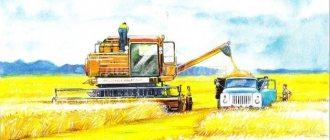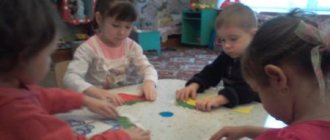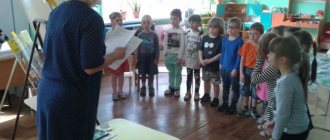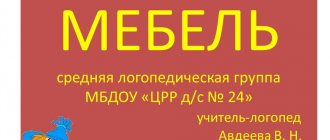Calendar thematic planning in the second junior group on the topic “Me and my friends”
Transcript
1 MBDOU “Kindergarten 39” Calendar thematic planning in the second junior group on the topic “Me and my friends” Compiled by teacher: M.Yu. Safronova
2 Topic of the week: “Me and my friends.” Goal: To teach children to treat children and adults in kindergarten kindly and to communicate with each other. Develop a sense of self-confidence and a sense of teamwork. Develop emotional responsiveness. Improve yourself as a person through communication with people. Final event: entertainment “Good deeds, magic words.” Date of the final event: September 7 Date, Day of week 3.09 Monday Morning exercises. Complex “We are funny guys” Cognitive and research activities (FCCM) / ChHL Topic: “My friends” (V.N. Volchkova, N.V. Stepanova “Lesson notes in the second junior group of kindergarten”, p.). Goal: to teach children to treat each other and adults kindly; develop emotional responsiveness; improve yourself as a person through communication with people. Progress: 1. Conversation with questions for children; 2. Game “Name your friends by name” Motor activity (physical education) (according to the plan of the physical education instructor) Educational activity during special moments Conversation “Let’s be polite” - teach children to use polite words and expressions. P/I “Find your color” - consolidate children’s knowledge about primary colors. Monitoring the weather conditions. Goal: to learn to determine the time of year based on its characteristic features. Labor activity. Watering sand for play. Goals: to teach to maintain cleanliness and order in the area, to encourage adults to provide assistance; to consolidate the knowledge that dry sand crumbles, and if you water it, it becomes wet and you can make pies for dolls from it. Outdoor games: “Sparrows and a car.” Goal: to teach children to run quickly when given a signal, but not to bump into each other, to start moving and change it according to a signal from the teacher, to find their place. “Take care of the item.” Goal: learn to act and navigate by signal, in space, develop dexterity. Individual work D/I “Find a toy.” Teach children to indicate the location of the toy in speech using prepositions: “in”, “on”, “behind”, “about”; develop coherent speech. Development of movements. Jumping in place. Goal: to develop children’s ability to jump on the spot. children's activities, organization of RPPS for children's independent activities; album for viewing "Children". To form the concept of “Friends” in children. Cultivate friendliness towards your comrades in the group. materials: Watering cans, cubes and molds for each child to play with sand, dolls, cars. Introduce parents to the theme and goals of the week “Me and My Friends.” Consultation “Be not only a parent to your child, but also a close friend.” Listening to songs about friendship. Give children the concept of what friendship is. Invoke positive emotions when listening to songs. Exercise “The neatest” - teach you to take care of your appearance. Enter attributes for a role-playing game, game situation: “Friend’s birthday.” Teach children to perform a series of game actions based on the plot of the game. Cultivate friendly relations with comrades.
3 Day of the week 4.09 Tuesday Morning exercises. Complex “We are funny guys” Cognitive and research activities (FEMP). Topic: 1. Orientation in time. Morning. 2. Magnitude. Big small. 3. Quantity and counting. One is many. (E.V. Kolesnikova, “Mathematics for children 3-4 years old,” T.Ts. Sfera, 2016, p.) Goals: to introduce morning to the part of the day (to teach how to correctly use this term in speech); learn to guess riddles based on visually perceived information; compare familiar objects by size (big small), use these words in speech; identify signs of similarity between different objects and combine them according to this feature (big small); compare collections of objects, distinguish where there is one object and where there are many. Progress: 1. Game “When does this happen?” 2. Physical education. 3. Game “Big Small. 4. Game “One Many” Musical activity (music). Educational activities during sensitive moments Situational conversation “Who is your friend?” To form the concept of “friend” in children. Cultivate friendly relations with comrades in the group. Learn to select definition words for the word “friend”. Articulation gymnastics “Smile” (Appendix 8). Goal: development of the articulatory apparatus. Looking at the flower bed. Goals: continue to teach to distinguish and name two flowering plants by color, size, pay attention to their coloring; cultivate a love for nature. Labor activity. Digging up marigolds and transplanting them into boxes for further observations in a corner of nature. Goal: to cultivate a desire to participate in plant care. Outdoor games “Bird in the nest”. Goals: to learn to walk and run in all directions without bumping into each other; to teach them to act quickly on the teacher’s signal, to help each other. "Find your house." Goal: to teach how to quickly act on a signal and navigate in space. Learning the finger game “Hide and Seek” (Appendix 6). Develop speech and memory. To develop the ability to perform finger movements in accordance with the text of the poem. Individual work D/i “Wonderful bag” (Appendix 4). Goal: focus on the gender of a noun when defining an object by its characteristics. Development of movements. Jumping forward. Goal: to develop children’s ability to perform jumps on two legs while moving forward. D/i “One is many” (Appendix 3). Development of the ability to isolate individual objects from a group and form a group of individual objects. organization of RPPS for an independent book for viewing with poems by A. Barto “Toys”. To develop children’s ability to look at illustrations; evoke a desire to recite familiar poems by heart. materials: scoops, small toys, sports hoops, molds, spatulas, flower boxes. Games with sports equipment: a large rubber ball. Throwing a ball to each other in a circle. Develop team play skills. Strengthen the ability to throw and catch a ball. Memo “How to teach a child to communicate with peers.”
4 Day of the week 5.09 Wednesday Educational activities during special periods Morning exercises. Complex “We are funny guys” Visual activities (drawing/sculpting). Modeling (V.N. Volchkova, N.V. Stepanova “Lesson notes in the second junior group of kindergarten”, 2006, page Topic “To play with a friend, we need to roll a ball.” Objectives: to develop a playful idea in children. Consolidate children's knowledge about a variety of games with balls. Cultivate a friendly attitude towards friends. Convey the shape by rolling a ball in your palms. Progress: conversation about how you can play with a ball with friends; demonstration of the technique of rolling a ball in your palms; independent activity; result Motor activity ( physical culture.) Conversation “Teaching to communicate with each other.” Goal: to teach children to communicate with each other. To give the concept of what friendship is. To teach to convey feelings through affectionate, kind words. Observing trees in the fall. Goals: to teach children to see changes that happened to the trees. Labor activity. Cleaning up fallen leaves on the site. Goal: to teach to maintain cleanliness and order in the area for walking. Outdoor games: “Birds in the nests.” Goals: to teach to walk and run in all directions without bumping into each other; to teach them to act quickly on the teacher’s signal, to help each other. "Find your house." Goal: to teach how to quickly act on a signal, to teach how to navigate in space. Individual work D/i “Lay it out correctly” (Development of attention, thinking) Appendix 3. Tossing the ball up. To develop children's ability to throw a ball up and catch it with both hands. organization of RPPS for independent playing of musical instruments (tambourine, drum, bell). Fix the names of instruments and their sounds. materials: buckets for collecting garbage, a basket with toys for playing in the sandbox, balls, cars. Consultation “Crisis of 3 years”, “Features of development of children 3-4 years old” Reading the fairy tale “Under the Mushroom” by V. Suteev. Goal: To develop the ability to listen to a fairy tale, follow the development of the action, and empathize with the characters. P/i "Round Dance" (Appendix 7). Purpose: to teach children how to dance in a round dance; practice squats. D/i “What’s missing?” (on lexical topics) Learn to coordinate adjectives and nouns. Ira with building material “Let’s build a house for friends.” Develop constructive skills, consolidate the names of parts “cube”, “brick”. To develop in children a desire to be friends with each other, to enjoy the friendships of others.
5 Day of the week 6.09 Thursday Morning exercises. Complex “We are funny guys” Communication activities (speech development). Topic: “How a fox and a bull quarreled” (V.N. Volchkova, N.V. Stepanova “Lesson notes in the second junior group of kindergarten”, 2006, pp. Goals: sound culture of speech: to consolidate the correct pronunciation of sounds (b), (l); coherent speech: learn to answer questions and, based on questions, restore the content of the fairy tale; vocabulary and grammar: activation of the adverbs “hurt, sad, offensive.” Progress: teacher’s story of the fairy tale “How the fox offended the bull”; questions about the text of the fairy tale; verbal game “Good words to a friend”; reciting the proverb “If you don’t want to be hurt, don’t hurt others yourself” Musical activity (music). Educational activity during special moments Problem situation “A friend has fallen and is in pain.” Goal: to cultivate feelings in children regrets to comrades, to develop the ability to come to the rescue. P/game “On a Level Path" (Appendix 7). Purpose: to develop in children the coordination of the movements of arms and legs; to teach children to walk freely in a column one at a time; to develop a sense of balance, orientation in space. Observing birds while feeding. Goals: to instill a desire to take care of birds; develop knowledge about the habits of birds; cultivate a love for nature. Labor activity. Feeding the birds. Goals: to encourage independent fulfillment of basic tasks (feeding birds, cleaning the area); develop a desire to care for animals. Outdoor games. "Sparrows and the cat." Goals: learn to jump softly, bending your knees; run without touching each other, dodge the driver; quickly run away, find your place; Be careful when taking up space and do not push your friend. "Get in the circle." Goals: improve the ability to act with different objects; develop the ability to throw objects in a certain direction with both hands; develop eye, coordination, dexterity. Word game "Let's set the table for tea." Goal: introduce the names of tableware items into the children's dictionary, teach them to find the named items among others. Learn to name utensils and introduce them to the purpose of utensils. Give a general concept of “dishes”. Individual work D/i “Balloons” (Development of the ability to group objects by color) appendix 3. Learn to walk along a narrow path, maintain balance. Working with algorithms. Goal: to develop the ability to wash hands, following the sequence of the algorithm. organization of RPPS for independent watering of indoor plants. Teach children to care for indoor plants and make them want to take care of them. materials: dolls dressed for the weather, emblem masks, pencils, scoops, cars, bird food. finger theater "Ryaba Hen" - teach children to tell a fairy tale, accompanying it with acting out. with parents Consultation “Cultivating friendships in the game.”
6 Day of the week 7.09 Friday Educational activities during special periods Individual work Morning exercises. Complex “We are funny guys” Fine art activities (appliqué/design). Application with drawing elements. Topic: “I will give balloons to friends” (I. A. Lykova “Art activities in kindergarten”, junior group, planning, notes, methodological recommendations, Moscow 2010, pp.) Tasks: creating applicative pictures: rhythmically laying out ready-made forms (identical in size, but different in color) and carefully gluing them onto a colored background. Development of a sense of form and rhythm. Make children want to give nice gifts to their friends Motor activity (physical education). Appendix 2, complex 1, September). Game "I want to be friends with you." Goal: showing affection, friendliness to each other, uniting children, accumulating positive emotional experience, team building. Cloud watching. Objectives: to introduce various natural phenomena; show the diversity of water conditions in the environment; develop a creative attitude to work. Labor activity. Collection of fallen leaves and other debris on the site. Goal: to teach children to maintain order in the kindergarten area. Outdoor games: “Sun and rain.” Goals: to learn to walk and run in all directions without bumping into each other; teach them to quickly act on the teacher’s signal and help each other. "From bump to bump." Goals: continue to learn how to hop on two legs; jump from high objects, land softly, bending your knees; improve jumping skills. Take-out materials: Scoops, sandbox molds, cars, game cubes, chalk, gloves. Final event: Entertainment “Good deeds, magic words.” Goal: to encourage children to be kind and do good deeds. Objectives: 1. Teach children to consistently express their thoughts, form new words, and answer with complete answers. 2. Develop logical thinking. 3. Cultivate a kind attitude towards yourself and other people. D/i “Multi-colored chest” (Appendix 4, card 2). Goal: to develop the ability to focus on endings when agreeing words in gender. "Get in the circle." C: develop the ability to throw objects in a certain direction with both hands; develop eye, coordination, dexterity. D/i “Say a polite word.” T: practice children in pronunciation of polite words, activate vocabulary on this topic. organization of RPPS for an independent book with Russian folk tales. Looking at illustrations. Arouse children's interest in fairy tales. materials: scoops, sandbox molds, cars, game cubes, chalk, gloves. Board games. Generate interest in board games. Explain the rules of the games chosen by the children. Invite parents to create a portfolio for their child.






